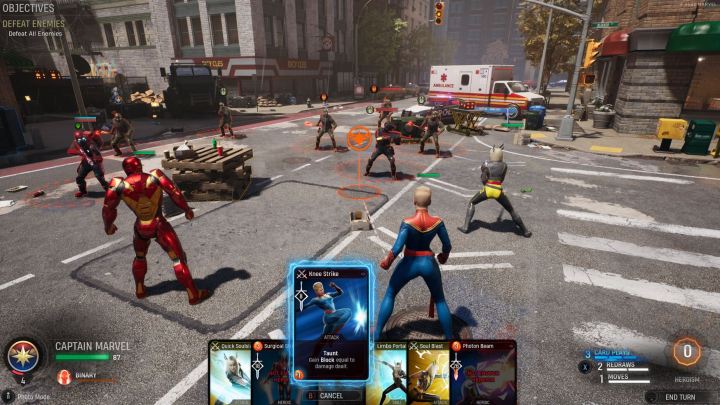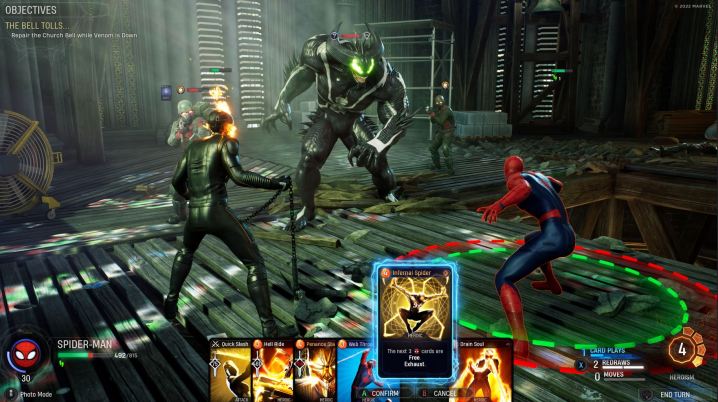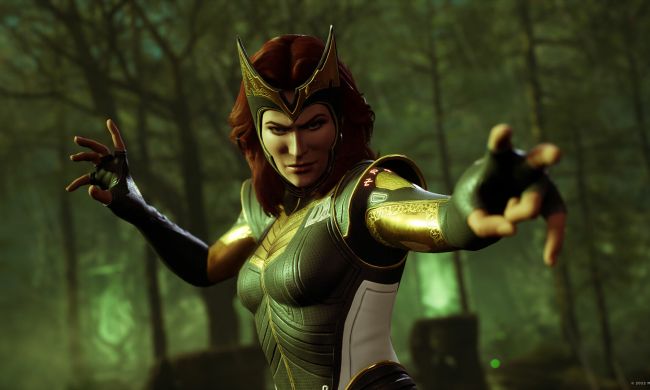Marvel’s Midnight Suns is not just XCOM with a Marvel Comics skin. It’s a card/strategy game hybrid that has players collecting cards, equipping each character with decks, and using those special abilities as they pop up during a fight. That then begs the question: Does Marvel’s Midnight Suns work as a card game? I’m dozens of hours deep into the game as part of the review process and can reveal that the answer is yes.
Dealt a good hand
Card games can be overwhelming to first-time players, as can strategy games, but Marvel’s Midnight Suns keeps things pretty simple. To start, players will only ever have three heroes come on a mission with eight cards each, so they are bound to see almost all of their 24 cards during a multiturn match. Players can also redraw two cards a turn, allowing them to get out of a situation where they have a terrible hand. Even as you get more powerful and diverse abilities later in the game, that never changes, making it somewhat easier to strategize than in some other card-based games.

Players’ hands start an encounter with six cards, with two more being dealt at the start of each turn. There are three types of cards: Attack, Skill, and Heroic. Attack cards, as the name suggests, will damage enemies and can have various other effects like Taunt or Knockback, which lets players change their position on the field. Protagonist The Hunter has multiple Attack cards that let her whip opponents around the field. On the other hand, Skill cards are often more support-based. They can buff the player, debuff enemies, or help set the player up in a more strategic position. For example, Magik can create a Portal in the environment that she can send enemies through with a Knockback ability.
Playing Attack and Skill cards accrue Heroism, which serves as Marvel’s Midnight Suns‘ version of the Mana-like mechanic often present in card games. Players can then use Heroism to do environmental attacks or, more importantly, play superpowerful Heroic cards with flashy animation and encounter-changing impacts. Nico Minoru has some of my favorites, including one called Witchstorm, which deals four powerful attacks to random enemies in an area of effect and quickly takes out many weaker enemies. This Heroism loop is at the core of Marvel’s Midnight Suns, and it’s a strong one that rewards playing smartly to build up Heroism to use the best moves.
Shaking things up
Of course, Marvel’s Midnight Suns wouldn’t be a card game if there weren’t other elements to shake those systems up. There are only three card plays, two redraws, and one character move a turn. This heightens the importance of each card play and makes Quick, an ability on some cards that restores a card play upon a KO, a necessity in many decks. Each hero has their own gimmicks, some of which are directly influenced by these systems. Namely, some of Doctor Strange’s abilities grow more powerful the more Heroism the player has, while some Iron Man abilities gain extra benefits upon being redrawn.

Each Marvel’s Midnight Suns character’s deck brings something different to the battle, making each encounter feel fresh, especially if the player uses a new combination of heroes that uniquely synergize with each other. I never felt overwhelmed by the cards and abilities at my disposal in Marvel’s Midnight Suns. Instead, I always looked for the most strategic combination of card games that would allow me to get more card plays and gain Heroism to access stronger abilities and environmental attacks that could defeat stronger enemies.
Marvel’s Midnight Suns features a solid and easily understandable gameplay loop that never overwhelms with too much randomness and supports the depth of strategy that developer Firaxis is known for. Hopefully, this quells your fears if Marvel’s Midnight Suns being a card-based strategy game concerned you.
Marvel’s Midnight Suns will be released for PC, PlayStation 5, and Xbox Series X/S on December 2. PS4, Xbox One, and Nintendo Switch versions are in development.



